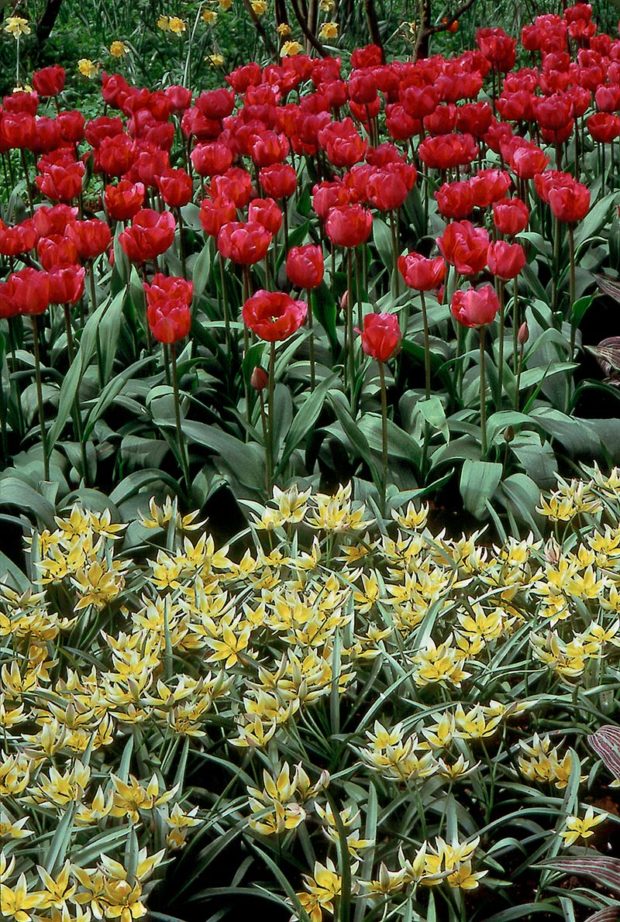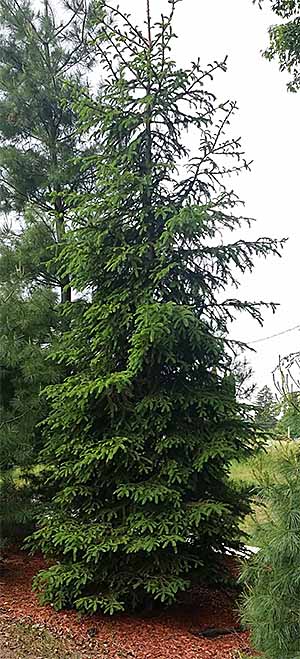
As spring bulbs begin to emerge, gardeners often wish they had planted more bulbs last fall. Few “perennials” are this easy to plant, grow, and maintain. However, many bulbs do have shortcomings. Some are planted and immediately become squirrel food. Others bloom so late that gardeners have to wait a few extra weeks for the foliage to die back before annuals can be planted. And the largest concern is their failure to bloom for more than a few years in the garden. Tarda tulip may help you overcome some of these potential problems.
Every year, in late April to early May, each tarda tulip (Tulipa tarda) bulb produces 4 to 6, star-shaped flowers that are about 2 to 3 inches across. The yellow buds open almost flat, revealing bright yellow petals whose lower half is white. Unlike most of the showier hybrids of today, tarda tulip’s flower size and color lends itself to a more refined and subdued display.
Tarda tulip is one of several tulips that can be found in nature, especially if you happen to be walking around the rocky slopes of rural China. Therefore, it is referred to as a species tulip—it hasn’t been bred for bigger blooms or brighter colors. Like several other species tulips, tarda tulip is extremely hardy. Severe winters and hot summers rarely threaten its vigor. This is especially true if you can create well-drained soil that is amended with organic matter such as compost or shredded pine bark. Plant bulbs at a depth of 6 inches in full or partial sun for best results.
The other great feature of this species tulip is its ability to flower year after year after year. Many of the more popular tulip types such as parrots, doubles, single lates, etc., have exceptional flower colors and forms. These, however, rarely last for more than a few years in the garden, even with the best conditions. On the other hand, tarda tulip is a true perennial type and should last for many years with minimal or no effort.
Tarda tulip’s short, yellow and white flowers make excellent partners for slightly taller tulips. Try a rock garden tulip (Tulipa greigii) for a 10- to 12-inch background. Then use the durable blossoms of grape hyacinths as a contrasting blue, spike-shaped flower that grows to about the same six-inch height. Don’t forget spring-blooming perennial groundcovers such as creeping phlox or candytuft. These can be planted right over tarda tulip for a brilliant, double dose of color every spring.
As for the squirrels, I can offer some ideas. The most reliable deterrent is to plant your bulbs under a piece of chicken wire that is buried below the soil surface. It always is effective but can be a chore to install and is especially annoying when it gets in the way of other plantings. Repellents can also be applied to bulbs before planting. These eventually wash away, but usually succeed because bulbs are the most vulnerable for a few days after planting. The good news is that tarda tulip is one of the least expensive tulips available. So, an occasional loss to Mr. Squirrel isn’t as economically devastating as it would be with other, more costly bulbs.
In the fall, tarda tulip can be found at many garden centers alongside other species tulips. Try these true perennials in your toughest areas and take advantage of their durability and beauty. It’s likely that these little gems will outlast your other bulbs and may even spread to fill nearby open spaces. Just remember to watch out for the squirrels.
Tarda tulip
Botanical name: Tulipa tarda (TOO-lip-uh TAR-duh)
Plant type: Bulb
Plant size: 6 inches tall
Hardiness: Zone 4
Flower color: White tips & yellow centers
Flower size: 2-3 inches across, star-shaped
Bloom period: Late April to early May
Leaf color: Green
Leaf size: 5 inches long
Light: Full to part sun
Soil: Well-drained soil, amended with organic matter
Uses: Perennial border, rock garden
Companion plants: Grape hyacinths, medium height tulips (10-14 inch), spring-blooming perennial groundcovers, such as creeping phlox or candytuft.
Remarks: Species tulip; very hardy; longer-lived than the more common, hybridized tulips.
George Papadelis is the owner of Telly’s Greenhouse in Troy and Shelby Township, MI.


